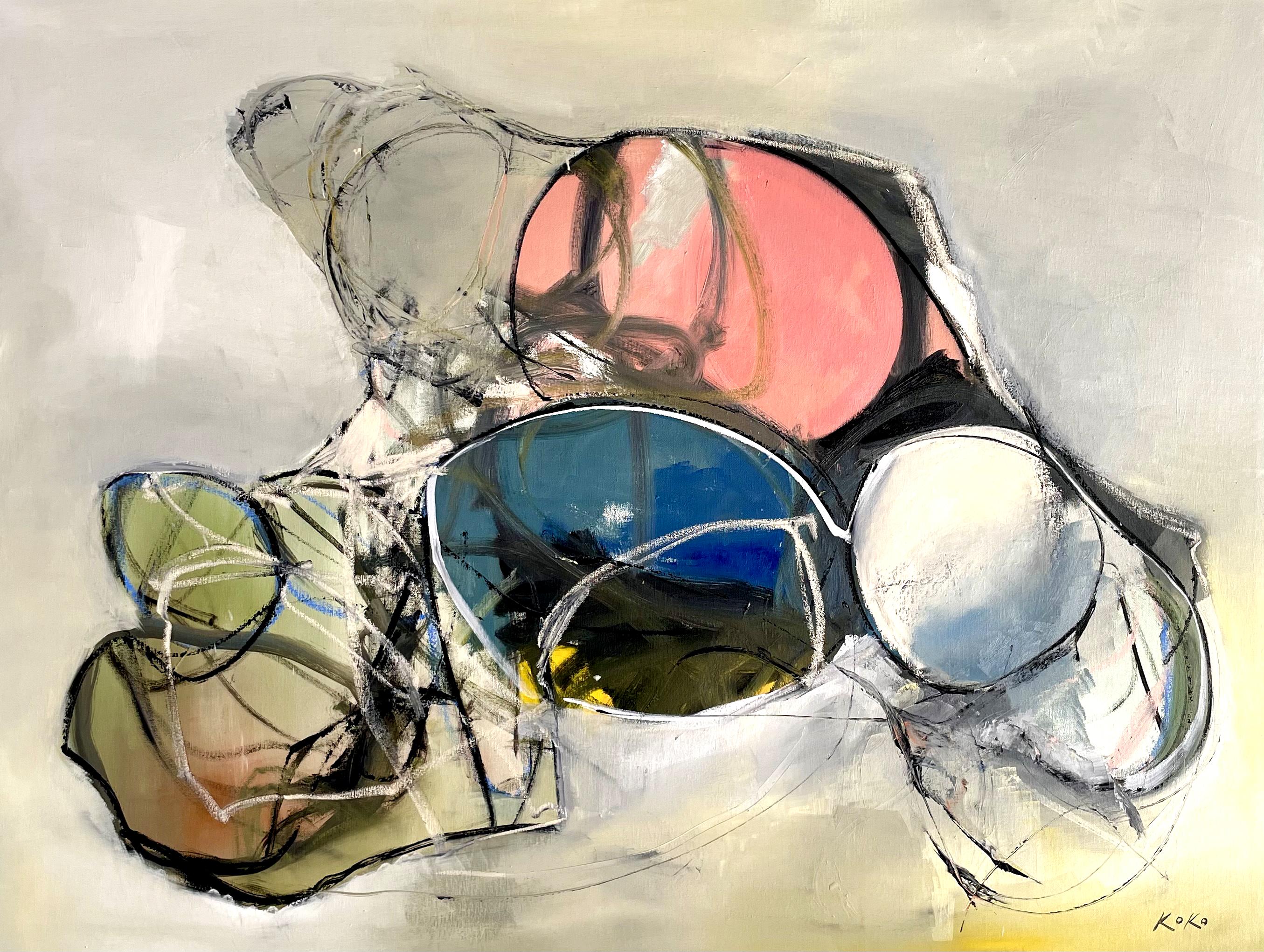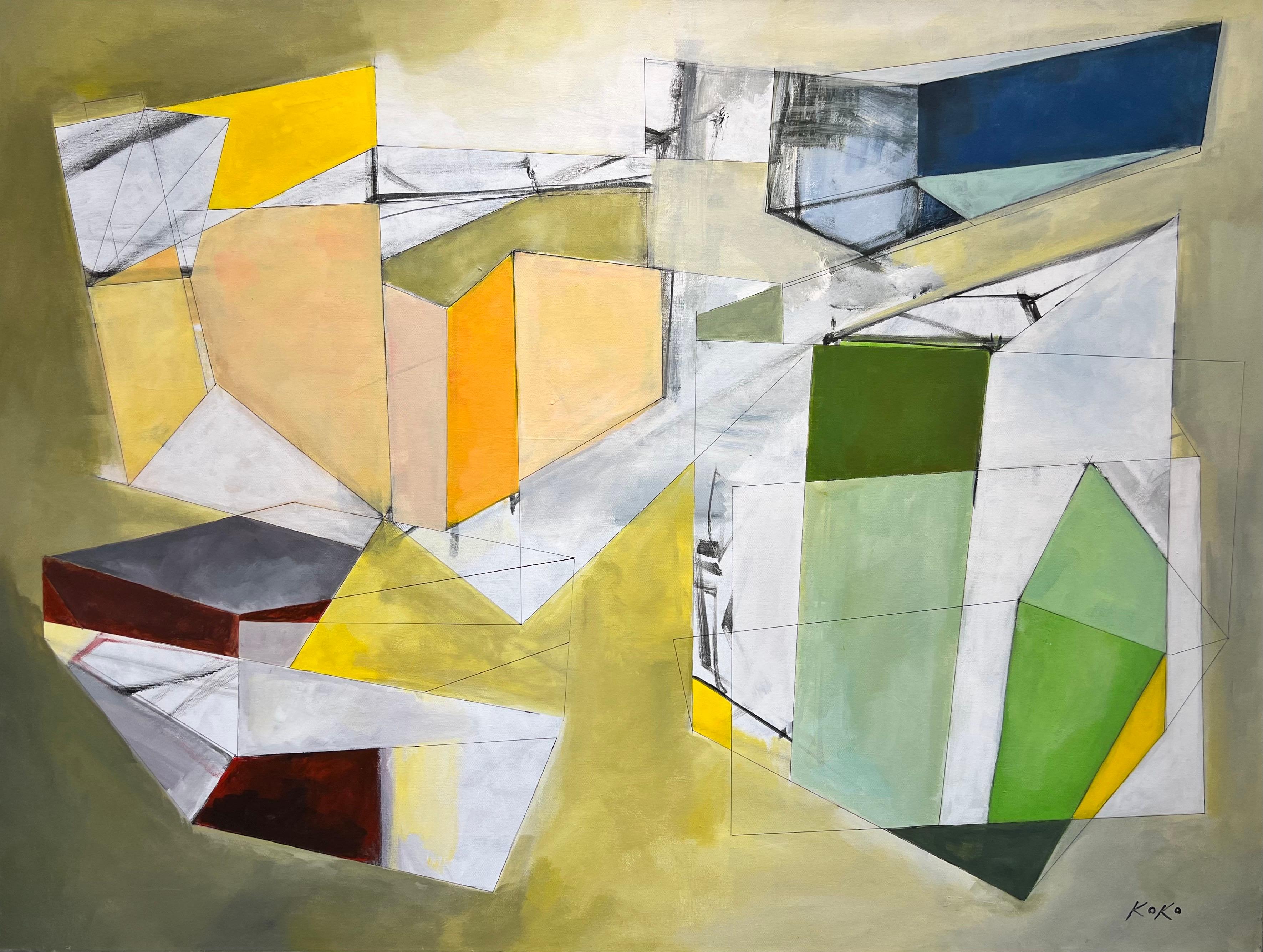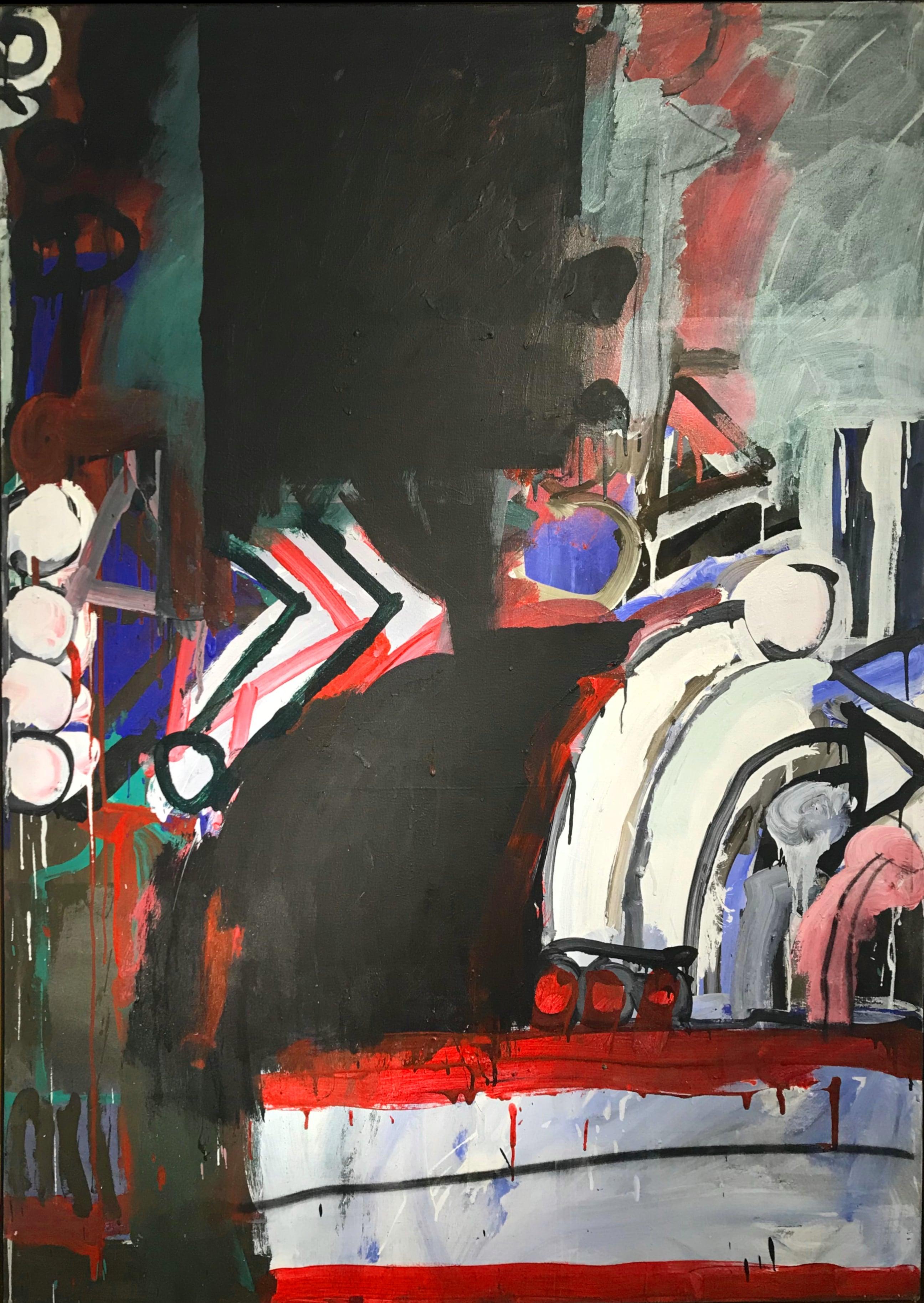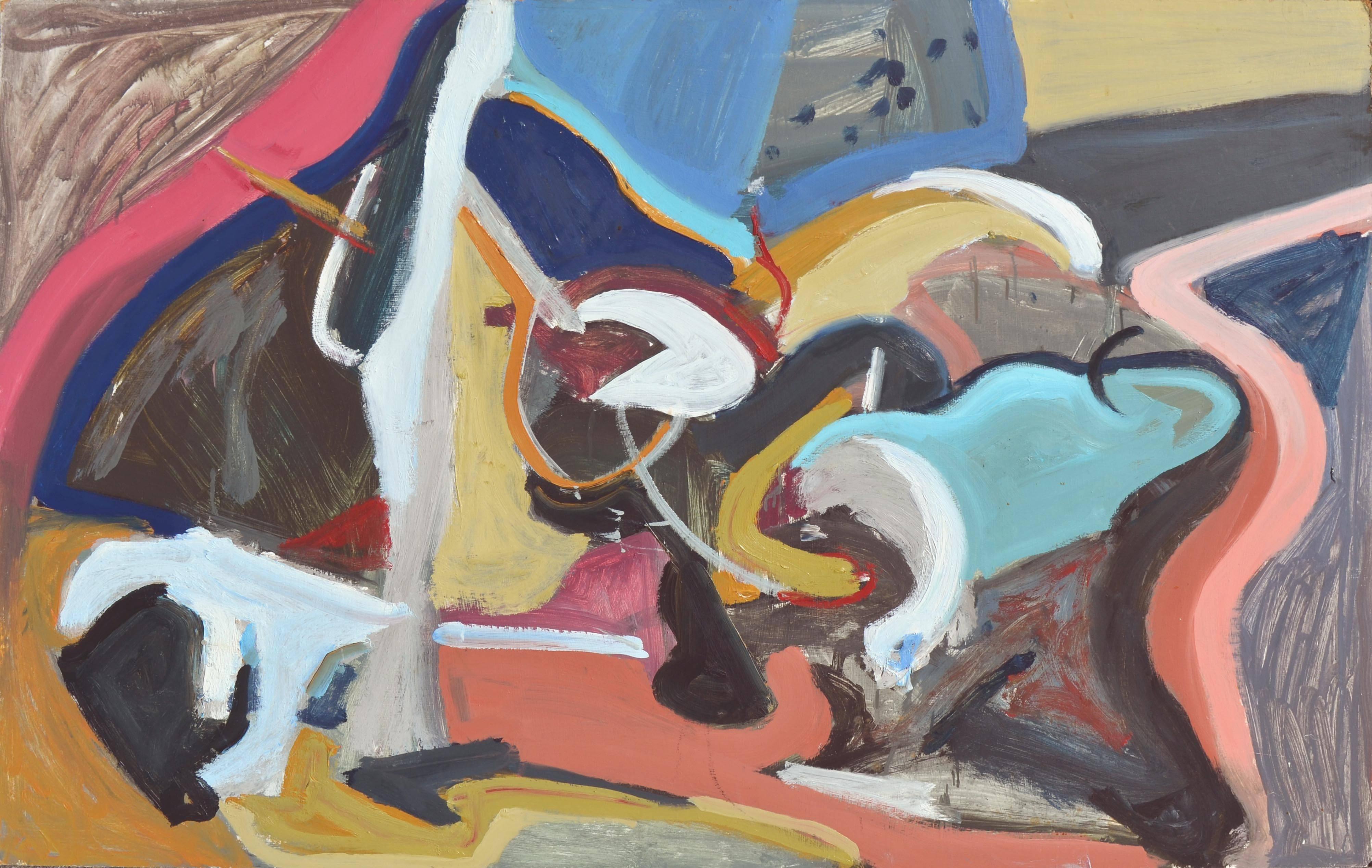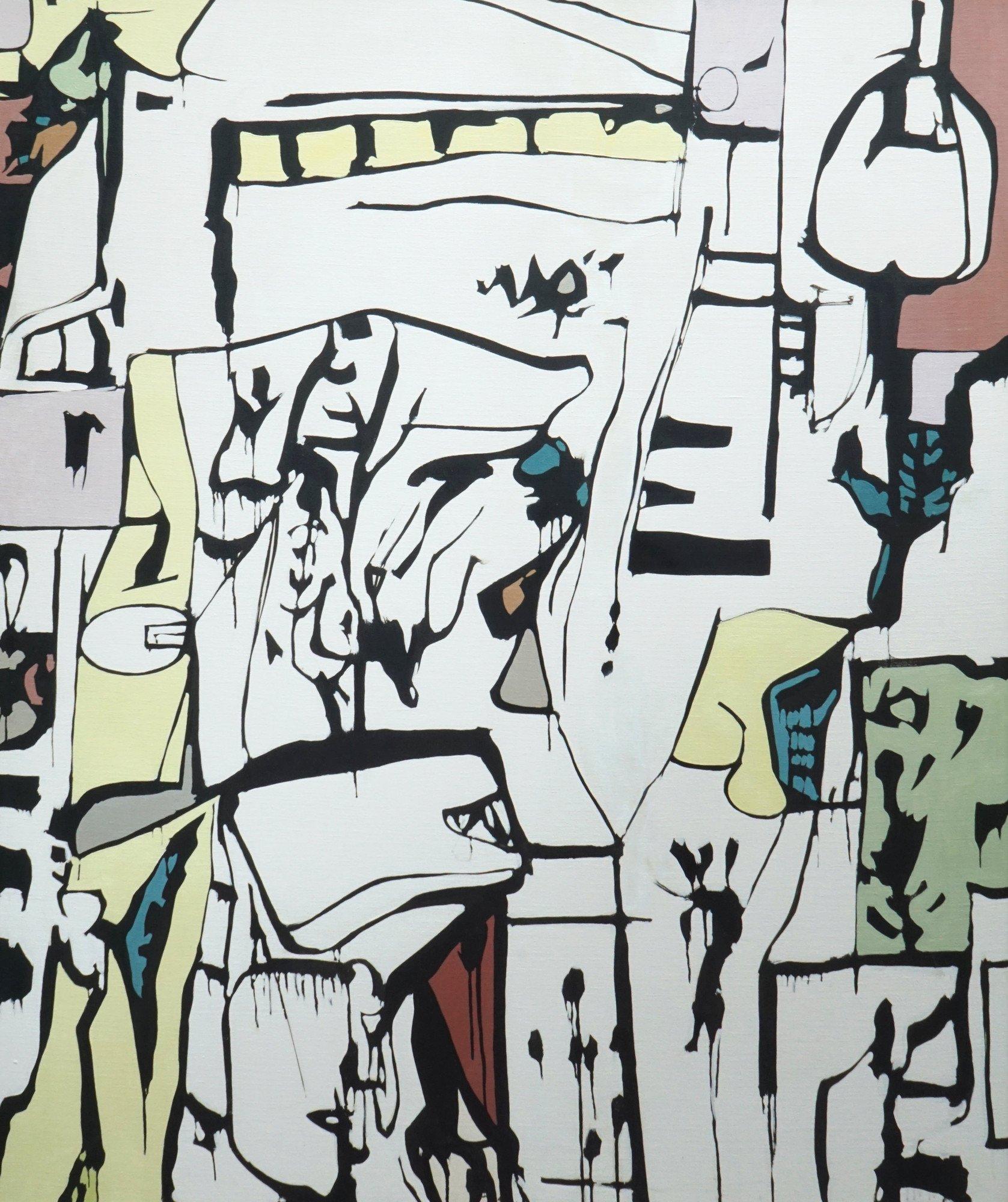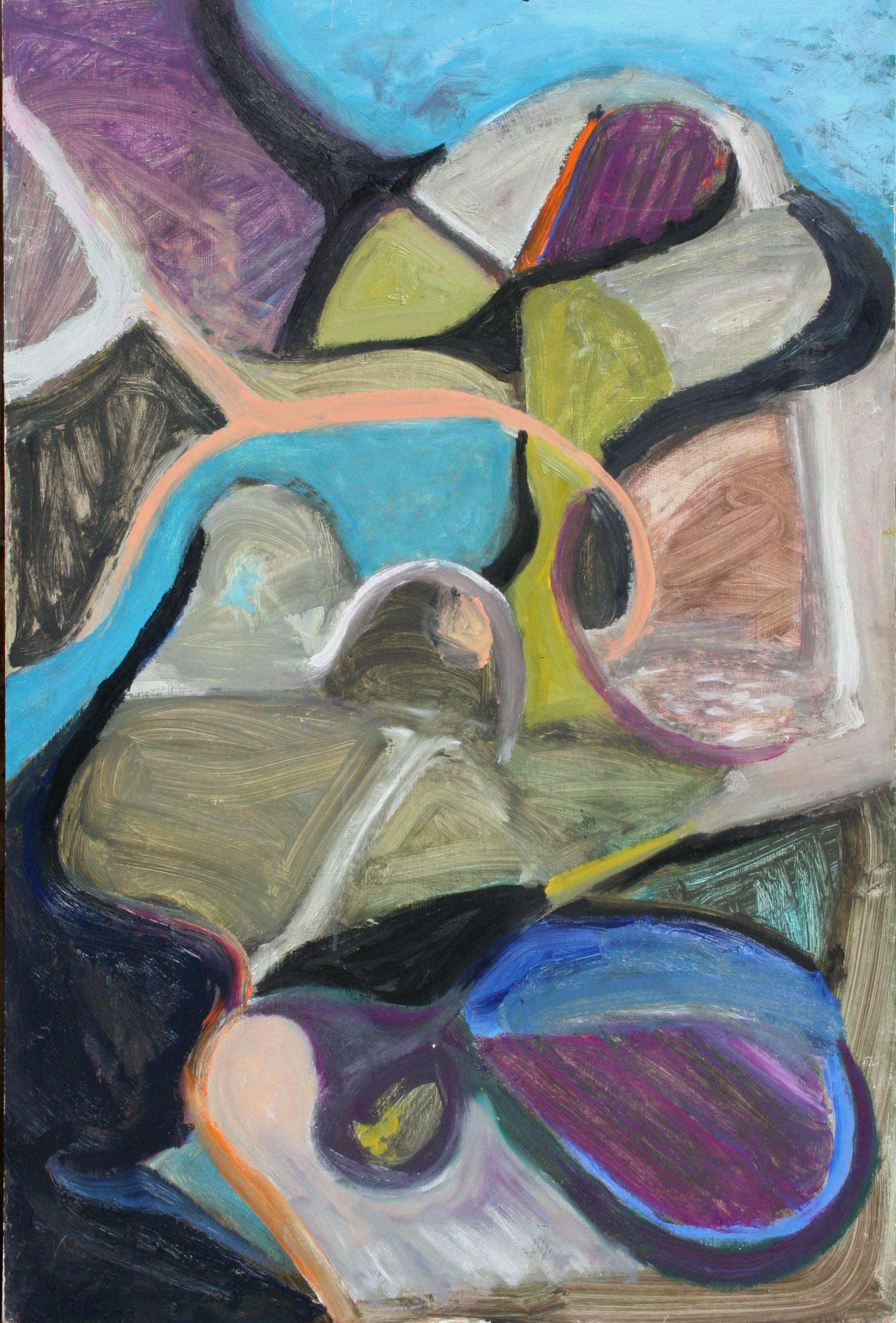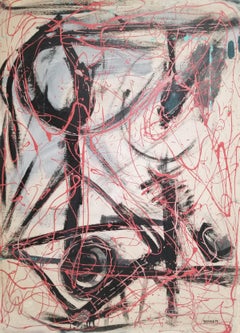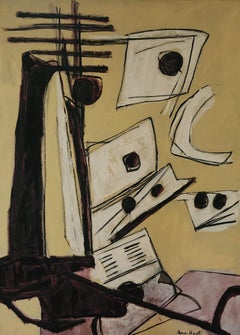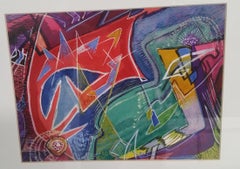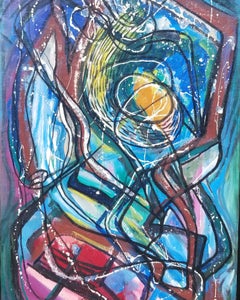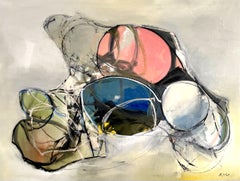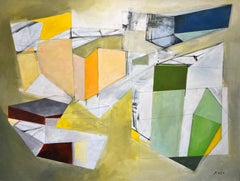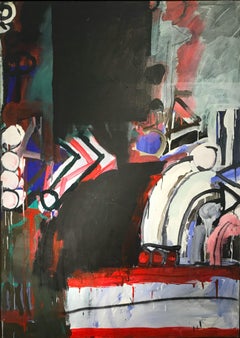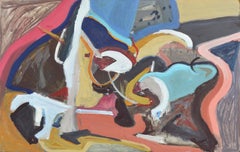Items Similar to Abstract and Fractured, Biomorphic and Geometric Forms
Want more images or videos?
Request additional images or videos from the seller
1 of 6
Agnes HartAbstract and Fractured, Biomorphic and Geometric Forms
$22,000
£17,043.74
€19,414.93
CA$31,498.24
A$34,398.50
CHF 18,056.28
MX$412,579.15
NOK 227,409.68
SEK 213,625.19
DKK 144,974.76
About the Item
Signed lower left.
“Abstract and Fractured Biomorphic and Geometric Forms” which was painted in the mid to late 1950’s is a nod to Picasso’s famous painting Guernica, which Hart may have seen when it was given to the Museum of Modern Art in New York in 1958. Several elements in the painting clearly reference Guernica: the black geometric and cut-out shapes, the biomorphic shapes, the abstracted horse’s head and body, with a district reference to the bull’s tail, along with the black and white pallet choice and various details throughout-all hallmarks of Picasso’s Guernica. The abstracted reality Hart presents in these references go beyond a simple nod and reflect a personal interpretation reflected in the splintered abstraction and her bespoke interpretation.
Agnes Hart’s first began her career as a social realist artist in the 1930’s. She was also WPA artist. Her longtime friend Milton Avery encouraged her, and she exhibited in the same gallery in the late 1940’s, the RoKo Gallery. Her instinctive and personalized modernist periods often reflected a similar path of her compatriot artists during the first half of the 20th century. Her early works were influenced by her teachers Josef Presser, Paul Burlin and Lucile Blanch, and Reginald Neal, and reflected historical modern trends-at times showing the influence of Avery and other modernist. Like Elaine DeKooning, Lee Kraser, Michael Corrine West, as well as other female artists, her career blossomed from the shadow of their husbands’ work. Agnes Hart developed a strong, determined, identifiable personal style while being married to the artist Joseph Presser. Her expression was independent and focused. She pushed the boundaries of modernism often instinctively toward geometric abstraction.
One-Woman Exhibits: the Roko Gallery in 1949. Woodstock, New York 1951, 1955, 1959, 1963, 1972; Mercer University in Georgia 1962; presentation show at Woodstock Artists Association 1953; Coral Gables, FL 1973.Group Exhibitions: Metropolitan Museum of Art, "American Painting Today" 1950; Art USA 1958; Brooklyn Museum; Pennsylvania Academy of Fine Arts; Philadelphia Art Alliance; Virginia Academy of Fine Arts; Toledo Museum; Springfield Museum; Chicago Art Institute; Butler Art Institute; National Academy of Design; Riverside Museum; New York Cultural Center; Long Island University; Berkshire Art Association; Eight at Phoenix Galleries; Galerie Interieur in Zurich, Switzerland.
(Source: Agnes Hart: Journey Toward Abstraction, Woodstock Artist Association and Museum Reference: askart.
- Creator:Agnes Hart (1912 - 1979, American)
- Dimensions:Height: 41 in (104.14 cm)Width: 61 in (154.94 cm)Depth: 2 in (5.08 cm)
- Medium:
- Movement & Style:
- Period:
- Framing:Framing Options Available
- Condition:
- Gallery Location:Saratoga Springs, NY
- Reference Number:1stDibs: LU17029336242
About the Seller
4.2
Vetted Professional Seller
Every seller passes strict standards for authenticity and reliability
Established in 1992
1stDibs seller since 2015
32 sales on 1stDibs
Typical response time: 16 hours
- ShippingRetrieving quote...Shipping from: Saratoga Springs, NY
- Return Policy
Authenticity Guarantee
In the unlikely event there’s an issue with an item’s authenticity, contact us within 1 year for a full refund. DetailsMoney-Back Guarantee
If your item is not as described, is damaged in transit, or does not arrive, contact us within 7 days for a full refund. Details24-Hour Cancellation
You have a 24-hour grace period in which to reconsider your purchase, with no questions asked.Vetted Professional Sellers
Our world-class sellers must adhere to strict standards for service and quality, maintaining the integrity of our listings.Price-Match Guarantee
If you find that a seller listed the same item for a lower price elsewhere, we’ll match it.Trusted Global Delivery
Our best-in-class carrier network provides specialized shipping options worldwide, including custom delivery.More From This Seller
View AllAbstract
By Rolph Scarlett
Located in Saratoga Springs, NY
Signed lower right and a double sided painting.
Category
Mid-20th Century Abstract Expressionist Abstract Paintings
Materials
Oil, Board
$35,000
Abstraction
By Agnes Hart
Located in Saratoga Springs, NY
Signed lower right
Agnes Hart was born in Meridan, Connecticut. She studied at the Ringling School of Art in Sarasota, Florida; at Iowa State University with Josef Presser, Paul Burlin and Lucile...
Category
1950s Abstract Abstract Paintings
Materials
Sandstone
$25,000
Abstract
By Rolph Scarlett
Located in Saratoga Springs, NY
Rolph Scarlett (Canadian/American, 1889 - 1984)
“Abstract”
Signed and dated 1947, lower right
Gouache on paper
Provenance: Private collection, Miami Florida
About
Rolph Scarlett w...
Category
1940s Abstract Abstract Paintings
Materials
Gouache
Abstract and Drip
By Rolph Scarlett
Located in Saratoga Springs, NY
Signed lower right.
Description
An example of Scarlett’s abstract drip painting, this untitled work has linear and geometric elements rendered in shades of black, rose, and blue and...
Category
1950s Abstract Expressionist Abstract Paintings
Materials
Canvas, Oil
Abstract
By Rolph Scarlett
Located in Saratoga Springs, NY
Signed lower right.
A major exponent of non-objective painting, Rolph Scarlett's career and artistic philosophy is closely linked with the early history of the Solomon R. Guggenheim...
Category
Mid-20th Century Abstract Abstract Paintings
Materials
Oil, Paper
$5,000
The Fern
By Agnes Hart
Located in Saratoga Springs, NY
Signed lower right
Agnes Hart was born in Meridan, Connecticut. She studied at the Ringling School of Art in Sarasota, Florida; at Iowa State University with Josef Presser, Paul Burlin and Lucile...
Category
1940s Abstract Expressionist Abstract Paintings
Materials
Canvas, Oil
$4,750
You May Also Like
Figure composition No. 1
By KOKO HOVAGUIMIAN
Located in La Canada Flintridge, CA
Signed lower right. Artist certificate of authenticiy is available.
Category
2010s Abstract Expressionist Abstract Paintings
Materials
Oil
Abstract Art. Deconstructed Study, Contemporary Art.
By KOKO HOVAGUIMIAN
Located in La Canada Flintridge, CA
Step into the calming world of abstract art with Koko Hovaguimain's Deconstructed Study. This mesmerizing piece features a harmonious blend of light green, yellow, orange, and white,...
Category
2010s Abstract Expressionist Abstract Paintings
Materials
Oil
Untitled
Located in New York, NY
This work conveys a sense of mystery and excitement carefully contained. Deep black in the middle draws the viewer in, provoking one to slowly expand their view out to the edges of t...
Category
Late 20th Century Abstract Expressionist Abstract Paintings
Materials
Canvas, Acrylic
Mid Century Abstract Expressionist Painting
By Leslie Luverne Anderson
Located in Soquel, CA
Colorful abstract expressionist piece by Les (Leslie Luverne) Anderson (American, 1928-2009) that lends itself to either vertical or horizontal orientat...
Category
1960s Post-War Abstract Paintings
Materials
Masonite, Oil
Garden, Abstract Expressionist Mid-Century Modern geometric work
By Richard Andres
Located in Beachwood, OH
Richard Andres (American, 1927-2013)
Garden, 1972
acrylic on canvas
signed, dated and titled verso
59.5 x 50 inches
Richard Andres was born in Buffalo, New York in 1927. A graduate of the Cleveland Institute of Art in 1950, he was immediately drafted and served for two years in the army as a mural painter. He received his Master of Arts from Kent State in 1961. A frequent exhibitor at galleries and museums and winner of multiple May Show prizes, Andres taught art in the Cleveland Public Schools for 28 years, as well as teaching the University of Buffalo, the Cleveland Institute of Art and the Western Reserve University.
Very little in Richard Andres’ childhood would have predicted his love of classical music, mid-century-modern architecture and certainly not his lifelong passion for art and in particular abstract art. Richard’s father, Raymond, had no more than a third-grade education, and his mother, Clara, was one of thirteen children – only three of whom lived into adulthood and none of whom attended high school.
They lived, when Richard was a boy, in a dingy area of Buffalo, NY in a walk-up apartment situated above a tavern. Raymond and Clara supplemented the income from their factory jobs in the bar downstairs with Raymond playing ragtime on the piano and Clara serving drinks. This often left Richard and his two older brothers at home alone to fend for themselves. The two older boys, Raymond and Russell, were - unlike Richard- rather rough and tumble and entertained themselves with stickball, boxing and the like. Richard, on the other hand, from a very young age liked to draw, or better yet even, to paint with the small set of watercolors he received for Christmas one year. Paper, however, at the height of the depression, was hard to come by. Luckily, Clara used paper doilies as decoration for the apartment and Richard would contentedly paint and then cut up doilies, gluing the pieces together to create collages.
At eight-years-old, he discovered the Albright-Knox Museum (then known as the Albright Art Gallery) and spent several hours a week there studying the paintings. He was particularly fond of Charles Burchfield‘s landscapes, enamored with their ‘messiness’ and thinking that they somehow captured more ‘feeling’ than works he was previously familiar with. For his tenth Christmas, he asked for and received a ‘how-to’ paint book by Elliot O’Hare. Through this self-teaching, he assembled the portfolio needed for acceptance to Buffalo Technical High School where he studied Advertising Arts. In his Junior year, he was encouraged to enter a watercolor painting, “Two Barns,” in the national 1944-45 Ingersoll Art Award Contest and was one of twelve grand prize winners – each one winning one hundred dollars. More importantly the painting was exhibited at the Carnegie Institute Galleries, which resulted in his winning a national scholarship to the Cleveland School of Art (The Cleveland Art Institute).
He flourished at the art school under the tutelage of faculty members such as Carl Gaertner, as well as that of visiting artists such as William Sommer and Henry George Keller. He would say in later years that Gaertner, in particular, influenced his attitude toward life as well as art. “Gaertner,” Andres said, “believed that there was no need to be a ‘tortured artist’, that an artist should rather enjoy beauty, family, and life in general.” Free to spend his days as he chose, he wandered the Cleveland Art Museum for most of the hours he was not attending classes or painting; the remaining time was spent drinking coffee at a local hangout with art school friends – which is where he met fellow Henry Keller scholarship winner, Avis Johnson. Richard was immediately smitten with Avis, but being rather shy, it took him the entire summer of 1948 to build up his courage to ask her out. Over that summer he ‘thought about Avis’ and worked in a diner to save money. He also used the hundred-dollar prize money won in High School to visit the first Max Beckmann retrospective in the United States at the City Art Museum in St. Louis. Over a half century later he spoke of that exhibit with a reverence usually reserved for spiritual matters, “I walked in and it was like nothing I had ever seen before... the color...It just glowed.”
Returning to campus in the Fall, the first thing he did was go to the coffee shop in hopes of finding Avis. He did, and she, upon seeing him, realized that she was also smitten with him. They quickly became known as ‘the couple’ on campus, and a year later, with Richard being drafted for the Korean war, they were quickly married by a Justice of the Peace, celebrating after with family at Avis’s Cleveland home. As a gift, faculty member John Paul Miller...
Category
1970s Abstract Expressionist Abstract Paintings
Materials
Acrylic
Mid Century Abstract Expressionist - Dreams
By Les Anderson
Located in Soquel, CA
Colorful mid century abstract expressionist painting by Les (Leslie Luverne) Anderson (American, 1928-2009). From the estate of Les Anderson in Monterey, California. Unframed. Titled...
Category
1960s Post-War Abstract Paintings
Materials
Masonite, Oil
$1,500 Sale Price
20% Off
More Ways To Browse
Head Of A Woman Picasso
Michael West
Joseph Presser
Lee West
Chanel Black And White Photography
Central Park Black And White
Dali Watercolor
Joan Miro Derriere Le Miroir
Mid Century Japanese Woodblock Print
Mourlot 1959
Sepia Photographs
1809 Art
Kaws Companion
Palm Springs Homes
Antique Postcards
Bronze Sculpture Of A Couple
Kate Moss Black And White
Alice In Wonderland
